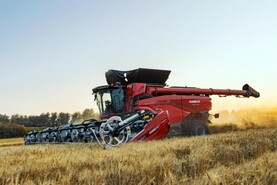Still a big tail: Last week’s forecast seemed good but the weather did not oblige in many parts of the country. The heaviest rain fell across the east and northern half of the country, where there is still quite a bit of harvesting to be done. Straw continues to be very difficult to save.
Harvesting of cereals is still to be completed while the planting season for winter rape tightens. Much of this is driven by the level of rainfall since June. It is interesting to note Met data put most tillage areas at around 75% of annual rainfall at the start of this week but Dublin Airport, Oak Park, Johnstown Castle and Moorepark were closer to 65%.
If my memory serves me right, this percentage was either side of 50% at the end of August last year and that August itself pulled it up that far. Whether this means that 2020 will be a ‘wet’ year or whether we can look forward to a ‘dry’ last quarter, only time will tell. Last year the inevitability of a wet backend was on the cards from the end of August, will it be the opposite this year? See the 2020 levels below.
Planting: There is still time to get remaining winter oilseed rape planted. No-till or strip-till systems may enable quicker establishment, but compacted ground needs to be loosened.
Soil temperatures are running slightly above average for the time of year and a ‘good’ backend could still give a lot of growth. The addition of some compound fertiliser, to supply up to 20kg N/ha, is advisable with later planting which might continue up to the middle of this month in the south.
Seed rates might now be 30-35 seeds/m2 for hybrids (bit less for Clearfield) and 75-85 seeds/m2 for any conventional varieties. Higher seed rates are not an alternative for poorer seedbed conditions.
While it is getting late for planting , oilseed rape is still a safer bet for planting in the mid-September window than any of the cereals. This is partly because of the higher pressure from BYDV and also from the higher risk of grassweed infestation associated with early planting.
Still a big tail: Last week’s forecast seemed good but the weather did not oblige in many parts of the country. The heaviest rain fell across the east and northern half of the country, where there is still quite a bit of harvesting to be done. Straw continues to be very difficult to save.
Harvesting of cereals is still to be completed while the planting season for winter rape tightens. Much of this is driven by the level of rainfall since June. It is interesting to note Met data put most tillage areas at around 75% of annual rainfall at the start of this week but Dublin Airport, Oak Park, Johnstown Castle and Moorepark were closer to 65%.
If my memory serves me right, this percentage was either side of 50% at the end of August last year and that August itself pulled it up that far. Whether this means that 2020 will be a ‘wet’ year or whether we can look forward to a ‘dry’ last quarter, only time will tell. Last year the inevitability of a wet backend was on the cards from the end of August, will it be the opposite this year? See the 2020 levels below.
Planting: There is still time to get remaining winter oilseed rape planted. No-till or strip-till systems may enable quicker establishment, but compacted ground needs to be loosened.
Soil temperatures are running slightly above average for the time of year and a ‘good’ backend could still give a lot of growth. The addition of some compound fertiliser, to supply up to 20kg N/ha, is advisable with later planting which might continue up to the middle of this month in the south.
Seed rates might now be 30-35 seeds/m2 for hybrids (bit less for Clearfield) and 75-85 seeds/m2 for any conventional varieties. Higher seed rates are not an alternative for poorer seedbed conditions.
While it is getting late for planting , oilseed rape is still a safer bet for planting in the mid-September window than any of the cereals. This is partly because of the higher pressure from BYDV and also from the higher risk of grassweed infestation associated with early planting.






 This is a subscriber-only article
This is a subscriber-only article









SHARING OPTIONS: